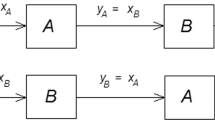Abstract
In this study, necessary and sufficient conditions for the decomposition of any second-order discrete-time linear time-varying system as a commutative pair of two first-order systems are presented. Commutativity conditions with zero initial conditions are first expressed by Theorem 1. Then, the conditions under nonzero initial conditions are studied and presented by Theorem 2. The results including decomposition formulas are well verified by examples worked by using MATLAB Simulink tool. The importance of the paper subject is emphasized in view of some engineering applications for getting better performance characteristics such as sensitivity, robustness and stability. In fact, the results of this paper can be used when the synthesis of a second-order system is made by cascaded and commutative pairs of simple first-order subsystems; and by using the explicit decomposition formulas derived in the paper this can be achieved very easily. Since different decompositions lead to different performance characteristics, one should choose the appropriate ones among them.





Similar content being viewed by others
Data availability
Our manuscript has no associated data.
References
M.R. Ainbund, I.P. Maslenkov, Improving the characteristics of microchannel plates in cascade connection. Instrum. Exp. Tech. 26(3), 650–652 (1983)
D.V. Balandin, R.S. Biryukov, M.M. Kogan, Minimax control of deviations for the outputs of a linear discrete time-varying system. Autom. Remote Control 80(12), 2091–2107 (2019)
I. Gohberg, M.A. Kaashoek, A.C.M. Ran, Partial role and zero displacements by cascade connection. SIAM J. Matrix Anal. Appl. 10(3), 316–325 (1989)
A.G.J. Holt, K.M. Reineck, Transfer function synthesis for a cascade connection network. IEEE Trans. Circuit Theory 15(2), 162–163 (1968)
D.N. Ibragimov, N.M. Novozhilin, E. Yu, Portseva1, on sufficient optimality conditions for a guaranteed control in the speed problem for a linear time-varying discrete-time system with bounded control. Autom. Remote Control 82(12), 2076–2096 (2021)
S. Ibrahim, M.E. Koksal, Realization of a fourth-order linear time-varying differential system with non-zero initial conditions by cascaded two second-order commutative Pairs. Circuits Syst. Signal Process. 40(6), 3107–3123 (2021)
S. Ibrahim, M.E. Koksal, Commutativity of Sixth-order time-varying linear systems. Circuits Syst. Signal Process. 40(10), 4799–4832 (2021)
M. Koksal, Commutativity of 2ND order time-varying systems. Int. J. Control 36, 541–544 (1982)
M. Koksal, General conditions for the commutativity of time-varying systems, in International Conference on Telecommunication and Control, Halkidiki, Greece (1984), pp. 223–225
M. Koksal, A Survey on the Commutativity of Time-Varying Systems. METU, Technical Report no: GEEE CAS-85/1 (1985)
M. Koksal, Effects of nonzero initial conditions on commutativity and those of commutativity on system sensitivity, in 2nd National Congress of Electrical Engineers, Ankara, Turkey, vol. 2/2 (1987), pp. 570–573
M. Koksal, Effects of nonzero initial conditions on the commutativity of linear time-varying systems, in International Conference on Modeling and Simulation, Istanbul, Turkey, vol. 1A (1988), pp. 49–55
M. Koksal, Effects of commutativity on system's sensitivity, in 6th International Symposium on Networks, Systems and Signal Processing, Zagreb, Yugoslavia (1989), pp. 61–62
M. Koksal, M.E. Koksal, Commutativity of linear time-varying differential systems with non-zero initial conditions: a review and some new extensions. Math. Probl. Eng. 2011(2011), 1–25 (2011)
M. Koksal, M.E. Koksal, Commutativity of cascade connected discrete-time linear time-varying systems. Trans. Inst. Meas. Control. 37(5), 615–622 (2015)
M.E. Koksal, Decomposition of a second-order linear time-varying differential system as the series connection of two first-order commutative pairs. Open Math. 14, 693–704 (2016)
M.E. Koksal, Commutativity of first-order discrete-time linear time-varying systems. Math. Methods Appl. Sci. 42(16), 5274–5292 (2019)
M.E. Koksal, A. Yakar, Decomposition of a third-order linear time-varying differential system into its second and first-order commutative pairs. Circuits Syst. Signal Process. 38(10), 4446–4464 (2019)
M.E. Koksal, An alternative method for cryptology in secret communication. J. Inf. Sci. Eng. 32(5), 1–23 (2020)
X. Lu, Q.Y. Zhang, X. Liang, H.X. Wang, C.Y. Sheng, Z.G. Zhang, W. Cui, Optimal linear quadratic Gaussian control for discrete time-varying system with simultaneous input delay and state/control-dependent noises. Optimal Control Appl. Methods 41(3), 882–897 (2020)
R.G. Lyons, Understanding Digital Signal Processing, 3rd edn. (Prentice Hall, New York, 2011)
E. Marshal, Commutativity of time varying systems. Electron. Lett. 13, 539–540 (1977)
B.T. Polyak, A.N. Vishnyakov, Multiplying disks: robust stability of a cascade connection. Eur. J. Control 2(2), 101–111 (1986)
J. Walczak, A. Piwowar, Cascade connection of a parametric sections and its properties. Przeglad Elektrotechniczny 86(1), 56–58 (2010)
Z. Zhang, W. Lin, L. Zheng, P. Zhang, X. Qu, Y. Feng, A power-type varying gain discrete-time recurrent neural network for solving time-varying linear system. Neurocomputing 388, 24–33 (2020)
Funding
No funds, grants, or other support were received during the preparation of this manuscript.
Author information
Authors and Affiliations
Corresponding author
Ethics declarations
Conflict of interest
The authors have no relevant financial or nonfinancial interests to disclose.
Additional information
Publisher's Note
Springer Nature remains neutral with regard to jurisdictional claims in published maps and institutional affiliations.
Rights and permissions
Springer Nature or its licensor (e.g. a society or other partner) holds exclusive rights to this article under a publishing agreement with the author(s) or other rightsholder(s); author self-archiving of the accepted manuscript version of this article is solely governed by the terms of such publishing agreement and applicable law.
About this article
Cite this article
Güneş, S.A., Köksal, M.E. Decomposition of Second-Order Discrete-Time Linear Time-Varying Systems into First-Order Commutative Pairs. Circuits Syst Signal Process 42, 2723–2739 (2023). https://doi.org/10.1007/s00034-022-02259-1
Received:
Revised:
Accepted:
Published:
Issue Date:
DOI: https://doi.org/10.1007/s00034-022-02259-1




